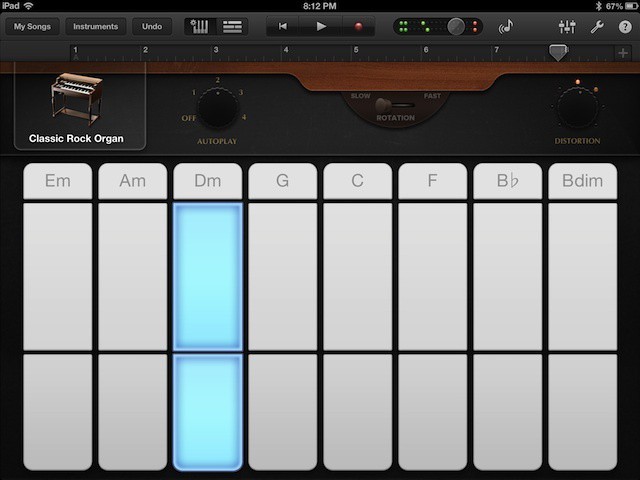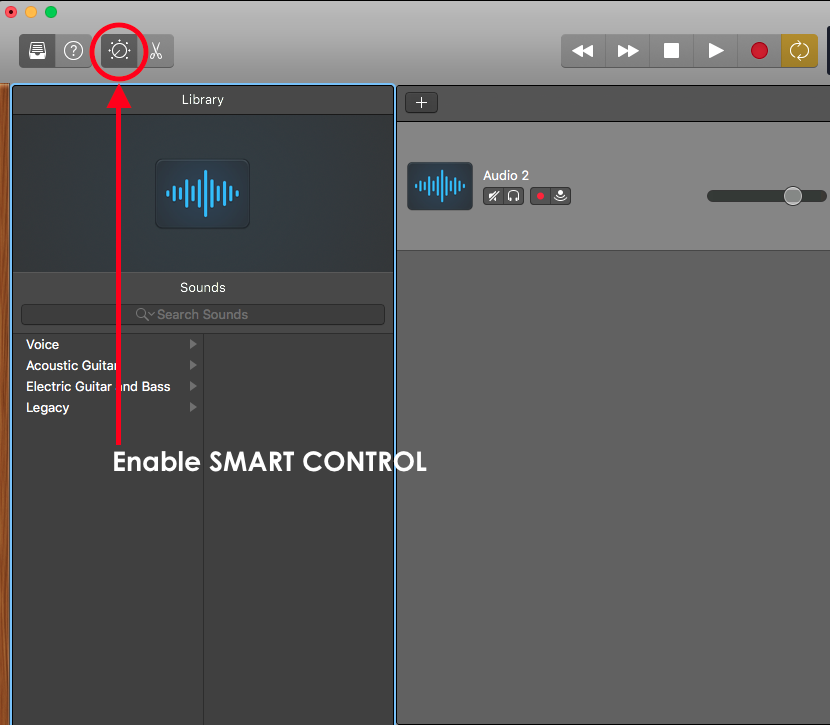Smart Guitar Garageband Mac
May 07, 2016 I can’t find a 100% bullet-proof answer, but several unofficial answers on the apple support site that indicate there are no smart instruments on the Mac version of Garageband. See search results: Smart Guitar osx site:apple.com Also, the GarageBa. Dec 10, 2019 GarageBand no longer hangs when opening the Sound Library, the Note Pad, the Loop Browser, or the Media Browser when the Smart Controls are open. Sound Library When opening GarageBand on a Mac in which the sound library has been moved using Logic Pro X or MainStage, and the external drive containing the library is not connected, GarageBand now. Baig You can connect real instruments, such as electric keyboards and guitars to your Mac for use in GarageBand. Using real instruments with GarageBand produces not only better sound, but realistic practice, as you finger the actual instrument and not an on-screen keyboard/string set.
- Garageband Smart Guitar Mac
- Smart Guitar Garageband Mac 10
- Connect Guitar To Garageband
- Smart Guitar Garageband Machines
- Garageband Download For Mac
So You Want To Record Authentic-Sounding Guitar In Your DAW
In this article, I’ll show you exactly how to plug your guitar into GarageBand. The way that I find works best is the most convenient and sounds pretty good as well while minimizing latency and other problems.
Now, the tactile thing: to use GarageBand on the Mac, you have to use a mouse or (if you’re really cool) a USB keyboard or a guitar with a fancy input. Playing keys with a virtual keyboard is. Another incredibly useful editing tool in Garageband is the (Command + J) function, which allows the user to essentially combine or merge the tracks together. This stops the user from having to copy and paste every little individual track. Instead, one can just merge all of the music together as one track, and then put it on a loop.
How to Plug Your Guitar Into GarageBand
There are a few different ways of doing this, and some are significantly better than others. I’m just going to show you the way that I do it.
I have a couple of pieces of necessary gear:
Amps: GarageBand includes a collection of modeled classic amplifiers—amps made by the likes of Vox, Fender, Marshall, and Mesa Boogie. The amps are paired not only with a particular speaker cabinet. Oct 07, 2019 GarageBand no longer hangs when opening the Sound Library, the Note Pad, the Loop Browser, or the Media Browser when the Smart Controls are open. Sound Library When opening GarageBand on a Mac in which the sound library has been moved using Logic Pro X or MainStage, and the external drive containing the library is not connected, GarageBand now.
- Obviously, your guitar.
- A Firewire to USB Cable
- an Audio Interface (I use the Focusrite Saffire 6USB. The Scarlett 2i2 is good too.)
- A USB-C to USB cable (The only reason this adapter is necessary is I’m using the latest edition of the MacBook Pro. The older generation MacBook Pro doesn’t need this adapter).
- Regular Guitar Cable.
If you’re new to music production, understand that a lot of this equipment will come in handy for years to come.
If you’re serious about recording and producing, much of this equipment and more are a necessity, so just grab some of it off Amazon and be done with it.
Without further ado,
The actual steps:
1) Connect your Firewire cable to your MacBook Pro. In most cases, this cable will come with your purchase of an audio interface, or a MIDI keyboard. However, if you don’t have one for whatever reason, I’m sure you can pick one up from Amazon for cheap.
Garageband Smart Guitar Mac
2) Usually, the port for the firewire cable is on the back of the Audio Interface. Plug the other part of the firewire cable into the back of the Audio Interface.
In my case, the Firewire to USB has to go into the USB-C adapter that I mentioned earlier.
3) Now, assuming you have the Focusrite Saffire 6USB, it should be powered by your computer. You don’t have to plug it in or anything like that, so all of its lights will turn on which you can see on the front of the unit.
4) Open GarageBand.

5) Click “Open Project,” or one of your old existing files. It doesn’t matter.
6) Once it brings up the “Choose A Track Type Page,” Click on where it says: “Built-in Input.”
7) This should be all that’s needed for this part of the process. However, assuming this is the first time that you’ve ever done this, it wouldn’t be a bad idea to click on where it says, “Built-in Output.”
8) That should bring up your “Output” and “Input” Devices under the Audio-MIDI region preferences.
9) Make sure you’ve selected “Built-in Output,” if you’re using your computer as your speaker, or the speakers that are hooked up to your laptop.
Virtual dj pro 7. 4 keygen download. The “Virtual DJ 2020 crack free download for pc gives you full premium software. People like to use it in Wedding sermonizes, live clubs, large stadiums, as well as private parties or even on a train and home also.
10) Select your Audio Interface for the “Input Device.”
11) Now, once you’re back at the “Choose A Track Type Page,” then click on one of the two subheadings below, either the “Guitar option,” or the “Microphone option.” This should bring up your MIDI Region and all of your controls.
12) In the “Smart Controls Area,” make sure that you’ve selected your audio-interface where it says, “Input.”
13) Now, plug your guitar into the front of your Audio Interface.
14) Click on the “Monitoring Button,” which looks like an upside down Wi-Fi symbol. This part is important, otherwise, you won’t be able to hear what you’re even playing.
15) You can now select whatever kind of amp you want, whether it’s a “clean guitar,” “crunch guitar,” “acoustic guitar,” “distorted guitar,” “experimental guitar,” “clean bass,” “crunch bass,” and “experimental bass.”
16) You want to hit the “Monitoring” button beside your track-header as well. I’ve highlighted the upside down Wi-Fi-looking symbol with a black circle. It’ll turn orange once it’s been selected.
Under each heading, there are quite a few options that all sound pretty good, especially after you tweak them to your preferences.
And it’s pretty much as simple as that.
Smart Guitar Garageband Mac 10
There are some problems that you can run into when doing all of this for the very first time. For that reason, I’ll explain some of the problems that I’ve had when I first started out.
Common Problems and Annoyances As A Beginner
1) Make sure that the gain on your Audio-Interface isn’t turned up too much, otherwise, you’re going to be feeding GarageBand too hot of a signal, which will make it sound distorted and bad.
2) Make sure the “Pad,” and “Inst,” buttons are turned off on your audio interface, assuming you own a Focusrite Saffire 6USB. I imagine there are similar controls on other audio interface models.
I find that these buttons make the signal too powerful as well, and thus, create distortion.
3) Latency. I’ve never actually had latency problems when using an Audio Interface, but some people do have this problem. I have an entire article on Latency which you can read more about here.
Essentially, if you’re having latency issues, there could be a number of different causes, however, most of them will be a result of your set-up and incorrect settings for your gear.
For instance, you want to make sure that – if you’re running more than one track – you have the monitoring button turned on for only one of them, rather than every single track.
Other Ways Of Recording Your Guitar In GarageBand

1) You can also use your MacBook’s microphone. This is for very rough demos, obviously, because this way of doing it is going to make a very low-quality recording. However, if you’re desperate, and want to record something, this method will work.
- To do this, you just open a new “Audio” track in your workspace.
- And then click on the “Record” button.
- Start playing the guitar with your amplifier close to it, and that should be enough for a very rough demo.
2) You can also purchase a Guitar to USB cable and hook your guitar directly up to GarageBand. This is an inferior way of recording guitar tracks as well, but it works if you’re running on a string budget.
(This is what a guitar-jack to USB looks like. I don’t own one so I couldn’t take a picture. I had to piece these two images together, but this is what it looks like).
GarageBand will immediately recognize this as an input, so you don’t have to worry about there being compatibility issues.
However, like the method above, you’ll likely run into latency.
3) Use a small portable audio interface if you plan on only running one instrument through your DAW. This is pretty much the same as the main method which I described in detail above.
The only difference is that you’ll be using a much smaller, and likely, limited audio interface. The good thing about this is that it’s relatively inexpensive. Small interfaces are becoming exceedingly popular, like the iRig for example.
I haven’t picked one of these up yet, but once I start traveling around Europe, I imagine I’ll eventually purchase one. I’ll make sure to write a review on it once I do.
Update: You have to use the iRig HD if you want it to work with a PC computer or Mac. The iRig 2 is only good for mobile.
4) Another popular way would be to mic your guitar amplifier up to your audio interface and then through GarageBand.
This is a decent option, but I prefer just to run my guitar directly through GarageBand, rather than doing this. Amplifiers are too big and cumbersome, and I would much rather limit the amount of gear I own.
Before playing your guitar in GarageBand, know that there’s an actually fairly useful tuning mechanism set up in the DAW. It’s not as good as a good old fashioned Korg tuner, but it still works pretty well. I usually use it if I’m too lazy to go over and grab my tuner.
How To Tune Your Guitar Using GarageBand
1) Your guitar is plugged into your audio interface in the computer, so it’s as simple as clicking on the tuning fork beside the center of the DAW where it shows the time signature, tempo, and key signature.
Mixmeister bpm analyzer help. 2) When you click on the tuning fork icon, it’ll bring up the meter where you can tune your guitar.
Other Features
Connect Guitar To Garageband
One of the great things about using a DAW for your guitar is all of the great VST plug-ins that you can use for your guitar.
For example, you can download amplifier simulators and cabs for your set up, and while it may not sound good as the original which the plug-ins are modeled after, they still sound good enough to use, and they’re good enough for the vast majority of people who aren’t tone-purists.
I’ll show you how to download plug-ins into your DAW in a later article.
That’s all for now. If this helped you out, do me a favor and share it on social media.